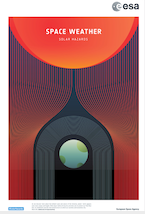Speaker
Description
In the field of space weather research, the monitoring of auroral emissions is one of the most powerful tools to obtain the particles precipitation spectra along the auroral oval. The concerned particles are mainly low energy electrons coming from the plasmasheet. Protons can also precipitate. These particles have energy ranges from tens of eV to keV. It represents one of the main energetic contribution to the solar wind through the magnetosphere. Considering this, we propose in the D3S mission frame, a wide field auroral hyperspectral imager (WFAI) with a FOV of 60°, 10 km of spatial resolution in the range of few nanometres. The instrument is a Fourier transform spectrometer based on Fabry-Perot principle. It uses several HDPYX CMOS detectors from Pyxalis company with 10 µm. The instrument can monitor the auroras between 350nm and 1000 nm (AOSI). It is joined with a FUV imager (AUI) equipped with three filters. (O 130nm, O 135nm, N2 LBH 138nm) with the same FoV. The FUV part of WFAI will allow to get information on the auroral emissions even in the dayside.

